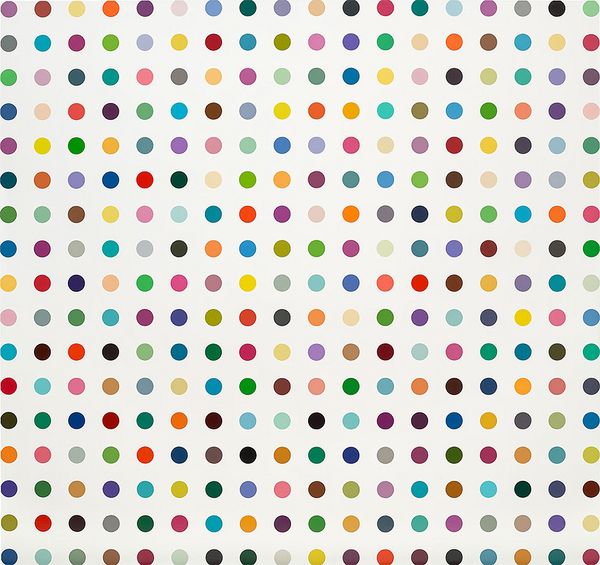Damien Hirst, Furfuryl Mercaptan, 2004-2011. 20th Century & Contemporary Art London.
Demonstrating on a grand scale Damien Hirst’s career-spanning interest in color and its organization, Furfuryl Mercaptan strikes a balance between art and science that has proven to be a conceptual touchstone for the artist’s practice. Bridging the sense of order and focus on scientific modes of categorization that we find in his earlier Medicine Cabinets with the exuberant approach to color taken in his Spin Paintings, the grid of 306 evenly spaced and uniquely colored dots are set against a brilliant white ground, perfectly uniform in compositional arrangement. The titles of works from this series were selected at random from the alphabetically arranged catalogue of drug company Sigma-Aldrich’s products that Hirst first stumbled across in the early 1990s. Furfuryl Mercaptan is most often used as a food flavoring agent, characterized by a bitter, coffee-like taste – an appropriate selection given the interplay between the work’s use of color and its conceptual basis of how the eye registers different hues.
Likened to an array of colored pills, the first spots date from the very outset of Hirst’s career, painted directly onto the wall of the Surrey Docks Warehouse in the final phase of the now legendary Freeze exhibition curated by Hirst as an undergraduate student at Goldsmith’s in 1988. Just as in the innovative Medicine Cabinets which he first embarked on during the same year, Hirst found that he could generate infinitely variable results from imposing certain limitations in terms of the size and color of his forms, their arrangement in relation to one another, and the number of spots, pills, or boxes included in each work. The grid structure of the Spot Paintings allowed for just such a formulaic approach. Arranged with 17 uniformly sized multichromatic spots along the vertical axis and 18 along the horizontal, Furfuryl Mercaptan possesses a striking sense of compositional balance and harmony in an almost pharmaceutical sense. One can easily imagine the television advert to accompany such an image: a chemical imbalance made stable as the previously irregular spots all align into a uniform, stable grid. Speak to your physician today.
The present work is rendered in mixed hues of household paint – no single color appears twice, and although created methodically by hand, Hirst was interested in the idea of the works appearing to have been executed by a machine, or “by a person trying to paint like a machine.” The colors possess a remarkable mutability when placed next to one another, some appearing to recede while others jump forwards in a manner that creates a sort of observer effect, and further an irony at the heart of the field Hirst examines – that of the idea that no two symptoms or cases are exactly alike, but uniformly, in the attempt to wrangle disparate individuals into a predetermined matrix of wholeness, there is, of course, a pill for that, highlighting what the artist calls a “scientific approach to painting in a similar way to the drug companies’ scientific approach to life. Art doesn’t purport to have all the answers; the drug companies do.”
Seen within the larger context of Hirst’s oeuvre, the work takes on additional meaning as a continuation of the process which began with the Medicine Cabinets and first spots of his formative years. Hirst has likened these arrangements to the simple geometries, harmony, and seriality of Minimalism, with a developed confidence immediately translated here, where the careful arrangement of colors evokes the clean, sterilized world of the pharmacy as much as the ailing body itself. The rigidity of the grid is offset by a more ineffable, poetic dimension that conflates ideas about medicine, art, and the ephemerality of life, while also borrowing from the colorful and loud use of ordinary shapes by 1960s Pop Art. As Hirst notes: “I once said that the Spot Paintings could be what art looks like viewed through an imaginary microscope,” and through this lens, each spot provides a single breakthrough as it falls in line for within the massive, prophylactic grid.
Discover More from 20th Century & Contemporary Art >
Recommended Reading
